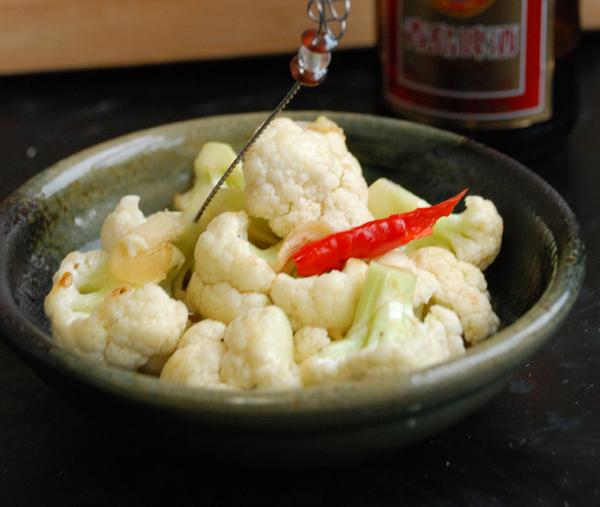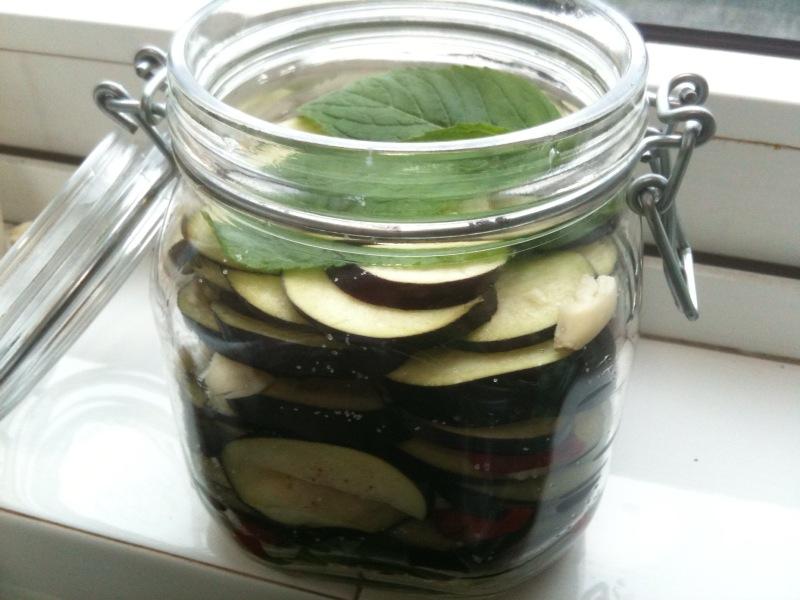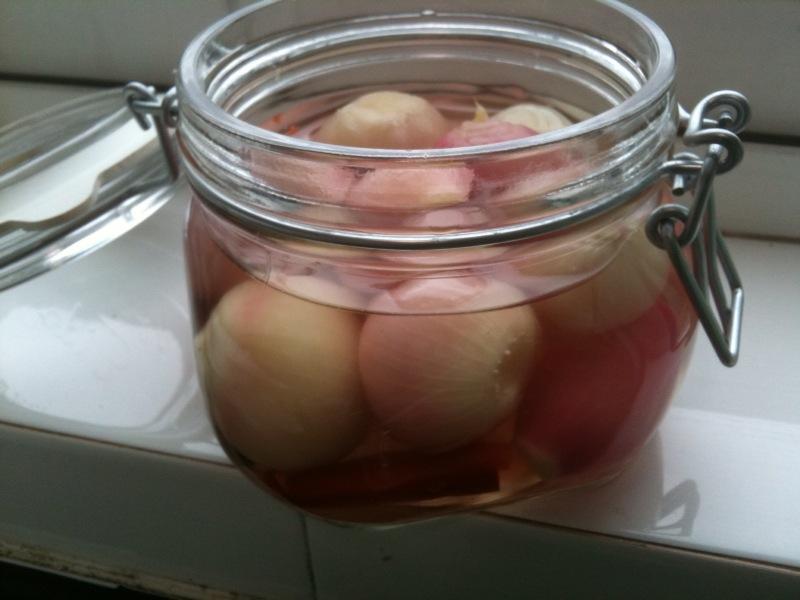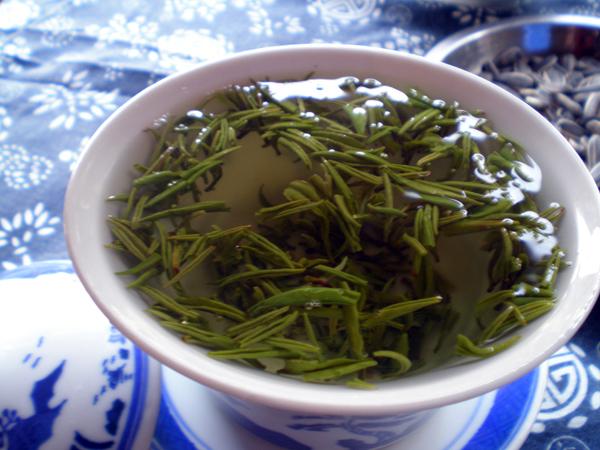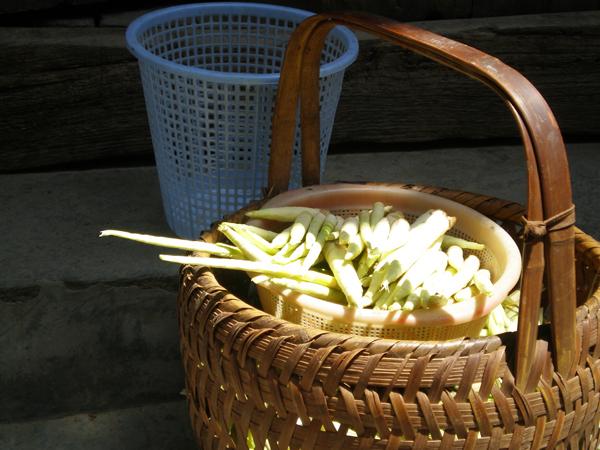-
Posts
3,664 -
Joined
-
Last visited
Content Type
Profiles
Forums
Store
Help Articles
Everything posted by nakji
-
The eggs! Four kinds - two kinds of chicken; quail, and duck, as a matter of course. Not in a specialty shop - in any shop. There is one decent produce shop in my hometown where the owner grows a lot of his own product on his own farm. He grows many of the vegetable varieties I have access to in Asia, so when I visit, I always take my parents round and point out all the vegetables that I've learnt about. Then we take them home and cook them together. Fortunately my parents are well-travelled, so they love taking chances on something new. The last time, I discovered "Turkish" cucumbers are an excellent substitute for Japanese ones.
-
Ha! Pasta! I'll make a pasta primavera. Great idea.
-
I used to get a "dry patch" at the bottom of my wok where the heat was the hottest, but now I've been using it for a while, this has disappeared. I clean my wok while the dish I've cooked in it is being carried to the table, while it's still hot. I put it under a hot tap, and scrape all the bits away with a wooden spatula. Then a quick tong with a dry paper towel to dry, then back on the heat - when it smokes, more oil goes in and I smear it around with tongs and a paper towel. I've never used salt or soap, even after getting rice stuck on it in the beginning. My patina has really come along.
-

A pictorial guide to Chinese cooking ingredients
nakji replied to a topic in China: Cooking & Baking
That doesn't look like any pinyin I've seen. In fact, muoi (with a hat on the "o") is the Vietnamese word for salt - maybe you've got a Vietnamese pack of salt on your hands? Muoi bien is probably "prepared salt" or similar. I live in Jiangsu province, near Shanghai. The (Chinese) salt I've bought at the supermarket is plain iodized(not sea or kosher) salt. Not sure if that's what's commonly used, but that's what's commonly available. Pepper comes in black and white at the supermarket, so again, I assume there's demand for both. All of the sugar I've seen in my area of mainland China has been made by the Tai Koo sugar company, from Hong Kong. It comes in white and brown, although I've no idea what people use for cooking. One thing that's worth thinking of is that China is as big geographically as the US, and there are all sorts of regional differences. Being honest, though, all of the staple products I buy in my local supermarkets look just like the ones I used to buy in Canada - I haven't noticed a big difference. Fuschia Dunlop specifies potato starch in all of her recipes as well, rather than the cornstarch thickener I was brought up using, but I just leave that step out of recipes anyway. -
I'm interested to hear advice about red shiso as well. I put some seeds into a pot a couple of weeks ago and just have baby sprouts right now. I'd like to keep them happy so I can replicate bun cha and other applications for this herb.
-
I think you'll enjoy that whole, book, not just for the pickles! Check out our topic on cooking with it. I pulled an eggplant out of the jar today to check, and it was perfectly done. Now all I need to do is get some other antipasto ingredients lined up for a proper plate. Jicama with lime! How exotic sounding. There's something very nice about the combination of crisp and tart. I have eaten all the onions in my small-batch onion jar, and am dealing with some cucumbers from my CSA bag. I'm wondering if I can re-use some or all of the vinegar from the onions with some new cucumbers. Does anyone else ever do that?
-
The taro is still eyeing me evilly from my crisper. I got a new bag today: More fresh peas; fresh spinach; a Korean zucchini; qing cai; some baby cucumbers; long thin green peppers that may or may not be banana chiles; and some onions and potatoes that have been held over the winter. Plus 5 kg more of "organic" rice, which comes once a month. The zucchini was made into a simple sauteed panchan with sesame oil to go with tonight's barbecued pork belly. The cucumbers I'm going to pickle. The green peppers/chilis will be stir-fried with pork and black bean sauce from "Revolutionary Cuisine". The qing cai will probably just get stir-fried along with that. The peas, however, I don't know about. It's only about 300g of pods, so the podded weight won't yield much. I've already made risotto. What can I do to highlight these gems?
-
One pickle I really enjoyed in Japan was daikon sticks pickled with yuzu zest, which is what made me think of it. What was her method to use the lemon juice - in place of or in addition to vinegar?
-
The small batch pickle topic got me thinking about these kinds of cookbooks again. I have only one - a small booklet I picked up in Vietnam but published in Australia simply called "Vietnamese Cooking". In it there are several recipes that are workhorses in my kitchen - chicken and cabbage salad; nuoc mam; caramel pork; and banh mi pickles. I think the thing cost me $3, but I can't even count the amount of times I turn to it for basic dishes I ate every day in Vietnam. Anyone else have any author-less gems?
-
When I return to Canada, more and more I'm shocked at the poor quality and variety of vegetables and meats available in my hometown. It seems like everything comes pre-cut and pre-washed in a plastic bag. There's a farmer's market that turns out some very nice produce in season, but the rest of the year, the Canadian climate works against that kind of bounty. That's why I'm so happy in Asia...it seems like I could try a new ingredient every day and never get tired. And here, vegetables are grown for their flavour and freshness, not their ability to traverse large distances and stay fresh-looking on a shelf. I know what you mean about not being rich...but I can feed myself as if I was shopping at Whole Foods as a matter of course here, for a fraction of the cost.
-
That's a very good tip. Did you use that pickle on banh mi? Cabbage kimchi is one thing I usually don't make at home, but I really enjoy making mul kimchi out of fresh napa. We have some discussion in our "Making Kimchi at Home" topic.
-
I tried the cauliflower pickles, and they rocked. Well, they look nice. What did you serve them with?
-
Oh, it smells a little like, uh, farts, yeah? Never figured out how to get around that.
-
Were you at a beer tasting, or just an exceptionally well-stocked party? I'm drinking Erdinger white and Qingdao in almost perfect rotation these days. I think I'd drink the Erdinger all the time, but for budgetary restrictions.
-
Great tip. My freezer's pretty small, so conserving space is important for me. I don't really freeze anything other than ice cubes and stock, but even still. Like I said, I mostly use my stock for soups and risotto, so I usually don't mind thawing a whole lot of it at once, but lately I've been using stock to finish stir-fried vegetables, so having cubes would be handy. The main problem for me: ice cube trays. I have exactly one, which is purposed for ice. Apparently, in China people think iced drinks are bad for your qi, so they're not readily available in every shop. I guess I'll have to make a run out to one of the big supermarkets.
-
Did she use lemon juice or lemon zest, or both?
-
I discovered my posh local supermarket sells chicken carcasses stripped for 8 kuai - around $1. That, combined with a pack of chicken feet should make for some decent stock. I'm trying to figure how to best store it, though. I don't want to put it into ice cubes, since I usually use stock for either a risotto or a soup. But I don't want to use up all my plastic containers, either. Is it crazy to put into ziploc freezer bags once it's cooled?
-
Do you store your teapot out, or in a dark cupboard? If you're worried, I'd keep it in a well-lit place. Things in my kitchen grow mold when they're left in the cupboard, but are otherwise fine when left out. If it's clean, with no oil or food related detritus on it, it should be okay.
-
Then I must share Harumi's recipe: Take one head of cauliflower and break into smallish florets. It should yield around two cups. Heat 45 ml of oil (sunflower or similar) in a frypan and saute four or five fat cloves that have been thinly sliced. When it has turned golden and is fragrant, add your cauliflower and two roughly chopped red chilies to the pan - I used small red Chinese chilis. Harumi says to seed the chilies, but if you like it hot, leave them in if you don't mind how it looks. Note - this isn't a sweet pickle, but it's addictively sour. You should saute the cauliflower quickly on a high heat. I did mine in a wok until the edges of the florets were crispy, the florets were still firm - about 2 minutes. Then add 1 tablespoon of chicken stock granules, 100 ml of rice vinegar, and one teaspoon of good soy sauce. Toss it about and serve. These are even better overnight, but our batch didn't last any longer than that. I wonder if small-batch pickles are getting more popular? Or do people who pickle still mostly can everything? I'd love to be able to can, but I don't have the space. How do you do your daikon - I often do mine Korean style - salted and sugared, then drained and sprinkled with chili powder, but it doesn't really keep. It's more of a salad. I'd love a recipe for pickled daikon cubes of the kind that come with Korean fried chicken. ETA photo
-
My husband and I really like to eat pickled vegetables, especially as a pre-dinner snack with a glass of beer or a bit of whatever the local tipple happens to be. I don't have a lot of space in my flat to keep canned pickles on hand - although I wish I did. So I've gotten in the habit of making quick pickles that last a week or so in the fridge; I like to search out recipes that make one or two bottles of something that I can have on hand for just such occasions. Sometimes I make fermented pickles like kimchi, but mostly I rely on brine or vinegar quick pickles. I made two today - one of my favourite recipes makes a small batch, although they're not particularly quick - is from Marcella Hazan's Italian Kitchen book. They're thinly sliced eggplants layered with salt, garlic, chili, and mint. Then you weight them and turn them upside down for 12 hours, then you vinegar them and do the same again for another twelve hours, then you cover the lot with olive oil and keep them in the fridge. Whenever I give them to anyone, they go crazy for them. They're really excellent on a sandwich as well. I also made a small batch - around 200g of pickled onions - these are in a vinegar solution flavoured with a cinnamon stick and a red chili. I'm looking forward to trying these with cheese. The recipe is from "The Korean Table". And last week I made a batch of hot pickled cauliflower with garlic and red chilis. The recipe was from "Everyday Harumi", and used vinegar. Instead of salt, however, the recipe uses chicken boullion powder. I'd post a picture of these, but we ate them so fast, they didn't stand a chance. Anyone else like making small batch pickled vegetables?
-
Are you talking beans in the pod? Or podded whole beans? Because this recipe sounds really nice, and I'm sitting on a stack of favas.
-
Sorry...it's beaten egg white alone, no sugar - so not a meringue. But the picture - if you could see it, you'd understand why I used the term. It looks exactly like a lemon meringue pie. So your book doesn't include a lot of egg-yolk-on-meat recipes? I have to admit I'm very intrigued by this method. There are two others I haven't seen before in my (admittedly shallow) exploration of Japanese cuisine: Eggplant with Chicken and Miso sauce and Fried Pork with Black Sesame Sauce - which calls for an extravagant 1/2 cup of black sesame seeds.
-
That afternoon we went to one of the most touristy of the villages in the area - Likeng. This village was swamped with tour buses, but we still managed to see enough of it to get a feel for the traditional nature of the area. It was really hot that afternoon, so the canal up to the village was covered with children on the banks with tubs of fresh raw cucumbers, a popular snack in Asia when it heats up. I did not indulge, as I prefer my cucumbers with dip. Around the village, and actually, in the whole area - we could see pork being preserved outside in the wind and heat. Here's a shot of one of the restaurants and their house charcuterie. It was still too early for dinner, so we stopped for a cup of local tea and sunflower seeds boiled with anise. The tea houses of Likeng overlook the canals and the rest of the village on lovely wooden decks. Ours was filled with Chinese families also taking a break from the heat with a restorative cuppa. The best part was wading through the piles of seed casings to our seats. I've never been much of a sunflower seed eater, but these were some of the biggest, fattest pods I've ever encountered, and the subtle anise salt makes them addictive eating. The view: Everywhere, thin yellow bamboo shoots were being offered for sale - I knew we'd have to order some of these for our dinner if we were going to have a true countryside experience.
-
In the town where I live, there's a small English lending library. It gets its books by buying old collections or books from various libraries in North America. There are, for example, a startlingly large number of books stamped "Burnaby Public Library". They're mostly fiction, but occasionally I stumble across a non-fiction gem, and last last night I found in the stacks "Typical JAPANESE COOKING" , edited by "The Japanese Cooking Companions" (no names given) with a publication date of 1970. A book like that begs to be signed out and brought home for further exploration, which is of course what I did. The recipe names, for the most part, have been translated into English, with the exception of sukiyaki and tempura, which the authors assume are popular enough to not need translation, I guess. All of the rest of the recipe names are painstakingly translated, resulting in dishes called, "Steamed Egg Moons" and "Fried Eggs 'Raft' Style" but in a charming counterpoint the recipes use the Japanese names for all of the ingredients - sensible in the case of miso and ponzu, but slightly more puzzling in the case of soy sauce, which is referred to as shoyu throughout the book - no doubt to draw a difference between more readily available (I assume at the time) Chinese soy sauce and Japanese soy sauce? Reading through the recipes, I can see that egg yolks are frequently called for to create crusts or sauces for meats, as in the case of "Chicken with Egg Yolk Sauce", which calls for chicken wings broiled in a sauce of four egg yolks, mirin, miso and ginger - very intriguing; but also in slightly-less-appealing ways, such as "Golden Roasted Pork", which has you grill then top pork chops with equal amounts of egg yolk and grated cheese mixed with sugar, sake, and salt. Even more dazzling is the recipe, "Chicken Pie Topped with Egg White Snow", in which a broad, round meatloaf is made out of ground chicken, then topped, lemon-meringue-pie style with piles of egg white, then grilled. I'm not familiar enough with Japanese cooking to separate out which of these recipes reflects a more traditional style of Japanese cooking, and which recipes may be responding to culinary fads of the time. I'm especially interested in the egg whites on chicken and fish. I feel like, at some point in Japan, I had grilled fish with a meringue on top, and I really liked it. (The book also has a recipe for a whole baked fish covered in meringue. There's lots of meringue) Any thoughts on the use of egg yolks and whites as sauces or garnishes in Japanese cuisine?
-
$4 a kilo here - they're imported, but from who knows where.


